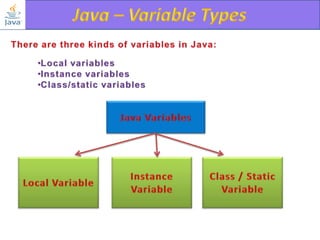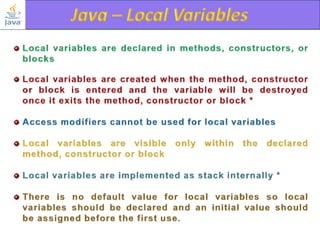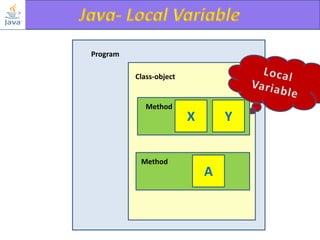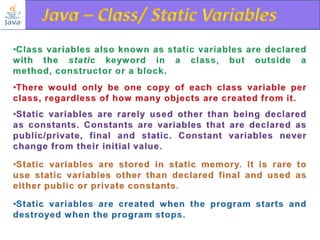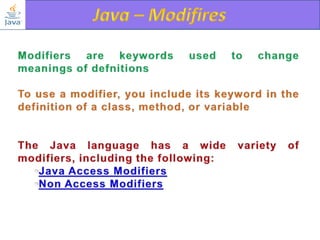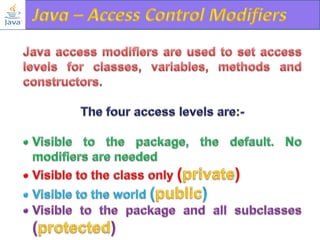java programming basics - part ii
- 4. Variables are nothing but reserved memory locations to store values A Variable has – Memory Address Name a 10 10110 Value int a=10;
- 5. There are two data types available in Java: •Primitive Data Types •Reference/Non Primitive/ Derived Data Types
- 7. There are eight primitive data types supported by Java. Primitive data types are predefined by the language and named by a keyword
- 8. Byte data type is an 8-bit signed integer Minimum value is -128 (-2^7) Maximum value is 127 (inclusive)(2^7 -1) Default value is 0 Byte data type is used to save space in large arrays, mainly in place of integers, since a byte is four times smaller than an int Example: byte a = 100 , byte b = -50
- 9. Short data type is a 16-bit signed integer Minimum value is -32,768 (-2^15) Maximum value is 32,767 (inclusive) (2^15 -1) Short data type can also be used to save memory as byte data type A short is 2 times smaller than an int Default value is 0 Example: short s = 10000, short r = -20000
- 10. Int data type is a 32-bit signed integer Minimum value is - 2,147,483,648.(-2^31) Maximum value is 2,147,483,647(inclusive).(2^31 -1) Int is generally used as the default data type for integral values unless there is a concern about memory The default value is 0 Example: int a = 100000, int b = -200000
- 11. Long data type is a 64-bit signed integer Minimum value is -9,223,372,036,854,775,808.(-2^63) Maximum value is 9,223,372,036,854,775,807 (inclusive) (2^63 -1) This type is used when a wider range than int is needed Default value is 0L. Example: long a = 100000L, int b = -200000L
- 12. Float data type is a single-precision 32-bit IEEE 754 floating point Float is mainly used to save memory in large arrays of floating point numbers Default value is 0.0f Float data type is never used for precise values such as currency Example: float f1 = 234.5f
- 13. double data type is a double-precision 64-bit IEEE 754 floating point This data type is generally used as the default data type for decimal values, generally the default choice Double data type should never be used for precise values such as currency Default value is 0.0d Example: double d1 = 123.4
- 14. boolean data type represents one bit of information There are only two possible values: true and false This data type is used for simple flags that track true/false conditions Default value is false Example: boolean one = true
- 15. char data type is a single 16-bit Unicode character Minimum value is 'u0000' (or 0) Maximum value is 'uffff' (or 65,535 inclusive) Char data type is used to store any character Example: char letterA ='A'
- 16. Reference variables are created using defined constructors of the classes They are used to access objects. These variables are declared to be of a specific type that cannot be changed. For example, Employee, Puppy etc. Class objects, and various type of array variables come under reference data type Default value of any reference variable is null A reference variable can be used to refer to any object of the declared type or any compatible type Example: Animal animal = new Animal("giraffe");
- 18. In Java, all variables must be declared before they can be used. The basic form of a variable declaration is shown here: type identifier [ = value][, identifier [= value] ...] ; The type is one of Java's datatypes. The identifier is the name of the variable. To declare more than one variable of the specified type, use a comma-separated list. Here are several examples of variable declarations of various types. Note that some include an initialization int a, b, c; // declares three ints, a, b, and c int d = 3, e, f = 5; // declares three more ints, initializing d and f byte z = 22; // initializes z double pi = 3.14159; // declares an approximation of pi char x = 'x'; // the variable x has the value 'x'
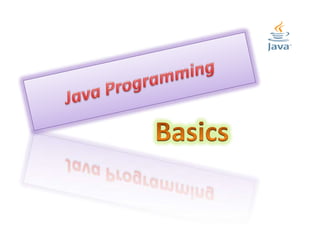
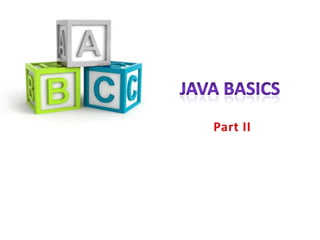
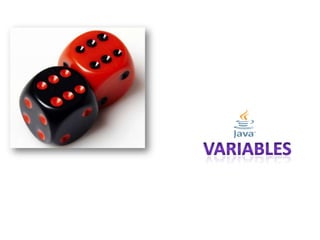
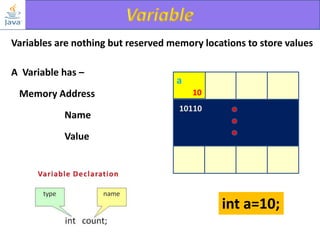
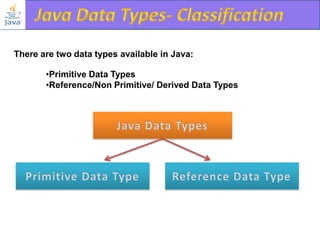

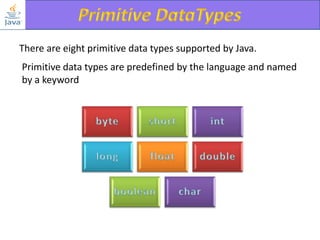
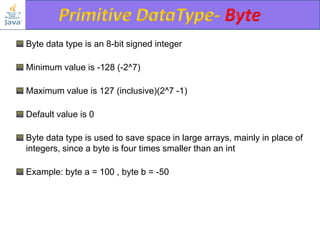

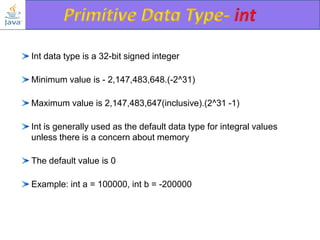







![In Java, all variables must be declared before they can be used. The basic form
of a variable declaration is shown here:
type identifier [ = value][, identifier [= value] ...] ;
The type is one of Java's datatypes. The identifier is the name of the variable. To
declare more than one variable of the specified type, use a comma-separated list.
Here are several examples of variable declarations of various types. Note that
some include an initialization
int a, b, c;
// declares three ints, a, b, and c
int d = 3, e, f = 5; // declares three more ints, initializing d and f
byte z = 22;
// initializes z
double pi = 3.14159; // declares an approximation of pi
char x = 'x';
// the variable x has the value 'x'](https://image.slidesharecdn.com/lecture3-javaprogrammingbasics-partii-131015055108-phpapp01/85/java-programming-basics-part-ii-18-320.jpg)
